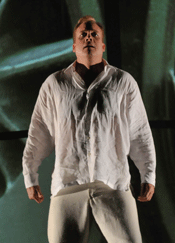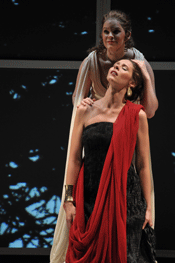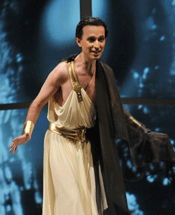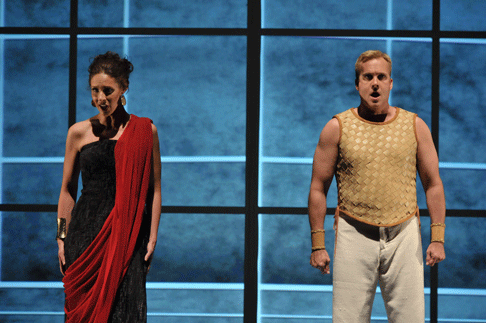Henze started composing when Arnold
Schoenberg and Richard Strauss were still alive; he is the last living link to
a continuous tradition of German opera reaching back for centuries. Yet his
Phaedra, composed in 2007 when the composer was in his early 80s, is as vital
and moving as any of his dozen previous operas. Presented by a brilliant and
committed young cast, it marks a special occasion for any serious
music-lover.
Phaedra retells the Greek myth of a step-mother’s fatally incestuous
love for her son—a theme that has fascinated playrights from Euripides to
O’Neill and composers from Rameau to Britten. Act One in Henze’s
libretto follows Euripides. When Hippolytus rejects Phaedra’s love, it
turns to hate. She plots his murder, then commits suicide out of shame. In the
background, goddesses make sport of men, with Aphrodite goading on Phaedra and
Artemis backing Hippolytus. In Henze’s Act Two, drawn loosely on Ovid,
Hippolytus is resurrected by Artemis, loses his memory, is imprisoned in a cage
and a cave, but in the end regains both freedom and identity.
 William Burden as Hippolytus
William Burden as Hippolytus
The work contains autobiographical resonances. Henze, in the classic mode of
German Romantics, moved in later life to Italy—by chance, close to the
spot where these mythical events are said to have occurred. He had finished Act
One when he suddenly fell into a coma for several months. He was expected to
die, but suddenly recovered. Seemingly revitalized, he wrote Act Two, with its
theme of reincarnation.
All this is reflected in Henze’s luminous, precisely constructed
score. Those familiar with his most famous operas, written in the 1960s when he
was engaged in broader social and intellectual causes, will note that the mode
of expression here is more private. One encounters neither the intricate and
dramatic interactions among the characters in Elegy for Young Lovers, nor the
symphonic sweep and struggle with implacable fate before a Greek chorus of Die
Bassariden. The characters in Phaedra barely take notice of one another or the
society around them. The dramatic focus lies instead on their interior
monologues.
Consistent with its private, existential emphasis, Phaedra is delicately
scored for five singers and an orchestra of 23 players. Yet it is miraculously
varied, evocative and often sensuous writing of a mature master. The style is
influenced, as always with Henze, by the second Viennese school—one key
reference being Alban Berg’s Lulu—with clearly audible elements of
Schˆnberg’s serialism, Stravinsky’s neo-classicism, Britten’s
sound-world, and Weill.
 Elizabeth Reiter (standing) as Aphrodite with mezzo-soprano Tamara Mumford (kneeling) as Phaedra
Elizabeth Reiter (standing) as Aphrodite with mezzo-soprano Tamara Mumford (kneeling) as Phaedra
Henze makes this all distinctively his own, creating unforgettable moments.
Phaedra and Hippolytus’s early dawn wanderings in the forest are
introduced by a sinuous duet for alto saxophone and English horn. The apex of
the opera, when Hippolytus questions his identity, is followed by the most
magically subtle suggestion of an orchestral storm: a brooding cello, swirling
woodwinds, and a light, almost Japanese, rainstorm of solo percussion. The
final scene, expressing the moral that we should dance our way through life
rather than hunting (or being hunted) in the labyrinth, wittily echoes the
finales of classic Baroque or Mozart opera.
Such writing imposes enormous technical and interpretive demands. Complex,
largely atonal passages, subtle shifts in dynamics and meter, and a wide range
of refined timbres must be performed in a limpid and fluid manner.
In Philadelphia, four outstanding young American singers take the leads.
Phaedra is movingly sung by young mezzo-soprano Tamara Mumford. Her uncommonly
expressive voice has increased in size since her successful Lucretia in
Philadelphia two years ago—almost to the limits of the role—yet
retains its plangent edge. Her elegant physical beauty perfectly suits
aristocratic women in uncomfortable circumstances, such as Lucretia and
Phaedra.
 Anthony Roth Costanzo as Artemis
Anthony Roth Costanzo as Artemis
Anthony Roth Costanzo, the leading American countertenor of his generation,
assumes the role of Artemis with clarity, precision and occasionally seductive
charm. His voice has also grown in recent years, perhaps—as with
Mumford—the result of singing at the Met.
William Burden, another returnee from the 2009 Lucretia, sings Hippolytus
with passion, musicality, and dramatic impact. To be sure, some might object
that the role of Hippolytus calls for less virility and a cooler and more
focused tone production—John Mark Ainsley sang the European premiere to
perfection—but Burden slims down to a ravishing “mixed voice”
when it matters most, as in the Act II scene starting “Bin ich ein
Vogel…”
Henze’s meandering, atonal phrases are murderously difficult to sing
precisely on pitch. Only Elizabeth Reiter, who sings Aphrodite, is fully up to
the task (though Costanzo comes close). Singing spot on pitch, she brings the
music suddenly into focus, revealing its Mozartian naturalness and grace. It is
hard to believe Reiter is a still a graduate student at Curtis—albeit one
already boasting Tanglewood, Carnegie Hall, and European credits. Jeremy Milner
is vocally and physically imposing in the cameo role of the Minotaur.
For all the vocal splendor—reinforced by the small confines of the
Kimmel Center’s Perelman Theater—the musical preparation is not
uniformly idiomatic. Both singers and orchestral players might take fuller
advantage of extensive dynamic markings in the score. And only Costanzo
consistently communicates of the eclectic pedigree of this music: where, for
example, are the Cabaret influences in Phaedra’s Weill-inspired Act II
seduction scene? German diction, though uniformly intelligible, remains uneven.
Vocal trills go missing. Some questionable orchestral intonation mars Act II,
and orchestral detail under Music Director Corrado Rovaris is lost. Yet such
issues may resolve themselves out during the 5-performance run of what is an
extremely difficult work.
 Tamara Mumford as Phaedra with tenor William Burden as Hippolytus
Tamara Mumford as Phaedra with tenor William Burden as Hippolytus
A more serious problem is that the visual treatment falls well short of the
high musical standard. The basic concept of the production is promising:
abstract, geometrical panels on which projections appear and in front of which
a large cage descends in Act Two to entrap Hippolytus. Yet the costumes,
make-up and stage direction fail to capture the mysterious essence of this
opera. In part this is because much of the production does not engage
Henze’s explicit instructions. One would never know that in the finale of
Act One, Henze’s score brutally confronts the audience with
Phaedra’s death: “The bang of a trap door. Phaedra hangs from a
rope.” In the final scene of Act Two, the stage directions read:
“In the background, the Minotaur dances,” evoking the archaic
strangeness of the libretto, as well as its aspiration to reconceive two
millennia of the Western tradition.
Such instructions need not be followed to the letter, but the
lowest-common-denominator realism of the Philadelphia staging—characters
in realistic costumes, little make-up and no masks, with pictures of birds and
trees behind them—seems banal and earthbound in a way fundamentally at
odds with the opera’s spirit. Expressionism or abstraction might better
convey that Henze’s characters are not, in the end, real people, but
archetypes engaged with central issues of Western culture.
Ultimately, however, the Opera Company of Philadelphia has rightly chosen to
emphasize first and foremost the music. Phaedra is a miraculous musical
achievement that combines the freshness of youth with the wisdom and skill of
old age. An opportunity to hear voices of this quality in a work of this
significance should not be missed.
Andrew Moravcsik
image=http://www.operatoday.com/fullres_2011_06_01_KM0262.gif
image_description=Tamara Mumford as Phaedra [Photo by Kelly & Massa Photography courtesy of Opera Company of Philadelphia]
product=yes
product_title=Hans Werner Henze: Phaedra
product_by=Click here for cast and production information
product_id=Above: Tamara Mumford as Phaedra
All photos by Kelly & Massa Photography courtesy of Opera Company of Philadelphia